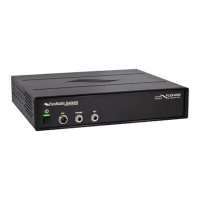FLEX-6000 Signature Series – FLEX-6000 Hardware Reference Manual
Page 33 of 48
Copyright 2016 FlexRadio Systems. All Rights Reserved.
Δ – As mentioned earlier, proper Electro-Static Discharge (ESD) and lightning protection
should be employed. It is outside the scope of this manual to go into details regarding
proper ESD protection. However, it’s important to note that this radio could be
connected to a potential ESD threat that you aren’t used to: the Ethernet connection.
Many times, adjacent ESD and lightning can enter a shack over the power, cable, or
telephone lines. The ESD will then “jump” your Internet modem device and travel
throughout the house on the Ethernet cable. A small investment in a 100Mbit Ethernet
Surge/Lightning Suppressor could save your expensive FLEX-6000 from damage.
8.4.2 Direct PC Connection (Link-Local)
The simplest method to connect your PC to your FLEX-6000 is using a Link-Local connection.
Simply plug the included Ethernet cable into the FLEX-6000 and then directly into the
network connection on your PC, Microsoft Windows™ will recognize your radio and
establish a local only connection. When the radio is activated, it will begin to broadcast it’s
presence on the Link-Local connection. Note that in Link-Local mode, your radio will not be
connected to or available to any other network connections on your PC.
I - It is not necessary to use a “crossover” Ethernet cable to establish a Link-Local
connection with the FLEX-6000. The Ethernet interface on the radio has a smart sensing
feature that will detect a Link-Local connection and make the proper adjustments
internally.
8.4.3 Connecting via a Local Network
The most versatile method to connect your PC to your FLEX-6000 is to connect your radio
to your existing local area network (LAN). Using the included Ethernet cable (or another
appropriate cable), plug one end into the FLEX-6000 Ethernet port and the other end into
your existing Ethernet switch or home router. With this LAN connection, your radio will
automatically receive a network IP address and begin broadcasting it’s presence with the
radio is activated. The advantage of the LAN connection is that all PCs on your LAN can
have access to the radio.
8.4.3.1 Network Configuration Considerations
There are several considerations when connecting your FLEX-6000 radio to your existing
LAN:
Your LAN must be configured to supply a network address to the radio. This is
known as Dynamic Host Control Protocol (DHCP). Most LANs do this by default. If
you can simply plug multiple PCs into your LAN to connect to the internet, your LAN
is very likely set up to serve DHCP to the radio.
Even though the FLEX-6000 is capable of operating in Gigabit, 100Mbit, and 10Mbit
LAN environments, FlexRadio highly recommends a minimum 100Mbit LAN
environment. Note that you can easily overload a 10Mbit LAN or LAN component
with FLEX-6000 running multiple panadapters and receivers.

